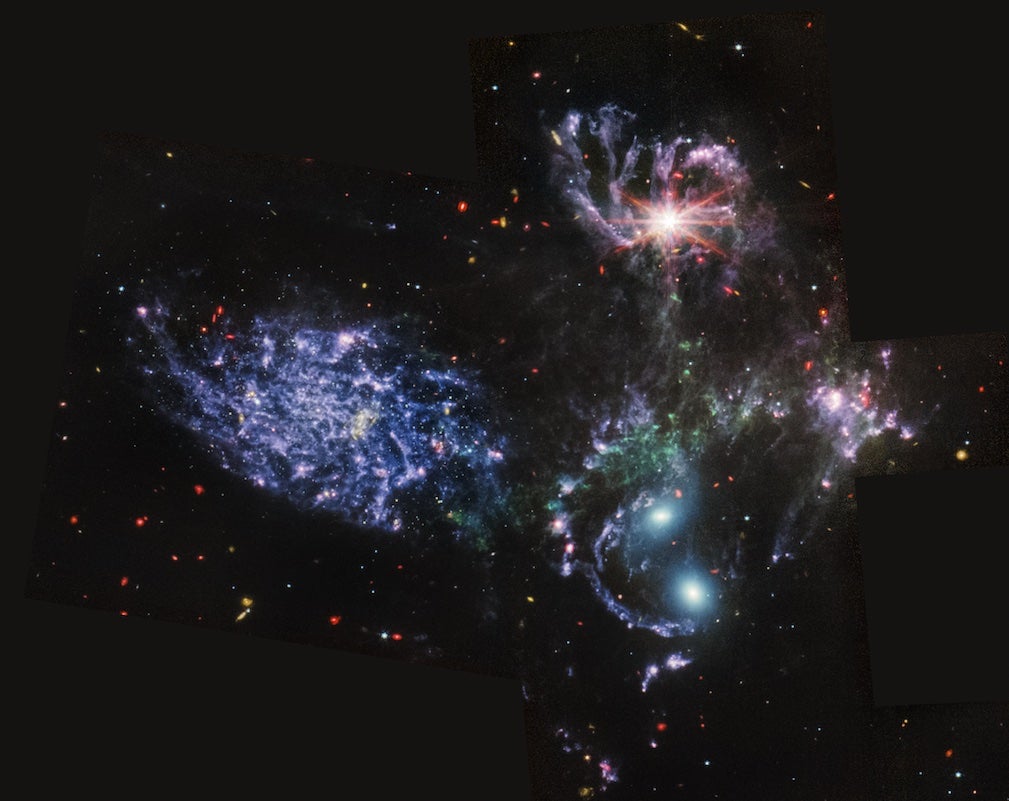
As a long-time observer of galaxies, I have a saying: “Why look at just one galaxy when you can look at multiple galaxies at the same time?” By observing groups and clusters, you not only get treated to the glow of potentially many trillions of stars all at once, but you can also survey the stunning diversity of galaxies without bouncing your scope around the entire sky.
There is a hierarchy for galaxies and their groupings, and it starts with singles. But true isolated galaxies are surprisingly rare. Many galaxies — like our Milky Way — have a few neighbors. Collectively, these are called groups, and they are the smallest associations of gravitationally bound galaxies. Groups of galaxies may be part of larger clusters, and aggregates of those are called superclusters.
How do we distinguish a group from a cluster? A typical group consists of three to five larger galaxies with a smattering of dwarf galaxies in tow. Our Local Group, for instance, consists of three major galaxies (the Andromeda Galaxy [M31], the Milky Way, and the Triangulum Galaxy [M33]) along with a relatively large dwarf (the Large Magellanic Cloud) and several dozen small to tiny galaxies. Each large member of the Local Group contains significantly more mass and stars than are found in all the dwarf systems combined. A cluster, meanwhile, contains a larger number, typically hundreds, of “regular” galaxies, each with roughly between 100 billion and a trillion stars. Superclusters, in turn, are gravitationally bound collections of up to hundreds of thousands of individual galaxies.
The closer a galaxy group is to us, the more widely its members appear scattered in the sky. For instance, at 13 million light-years distant, the Sculptor Group — home to the Silver Dollar Galaxy (NGC 253) — is sprinkled across three constellations, too dispersed to take in all at once. But similarly spread-out groups located farther away will fit in a wide-field telescope and are easier to explore at higher magnifications.
The 10 galactic gatherings highlighted below include three or more bright galaxies in the same field of view. Some are groups comparable to the Local Group, while others are dense regions within larger clusters.
Choice galactic groupings
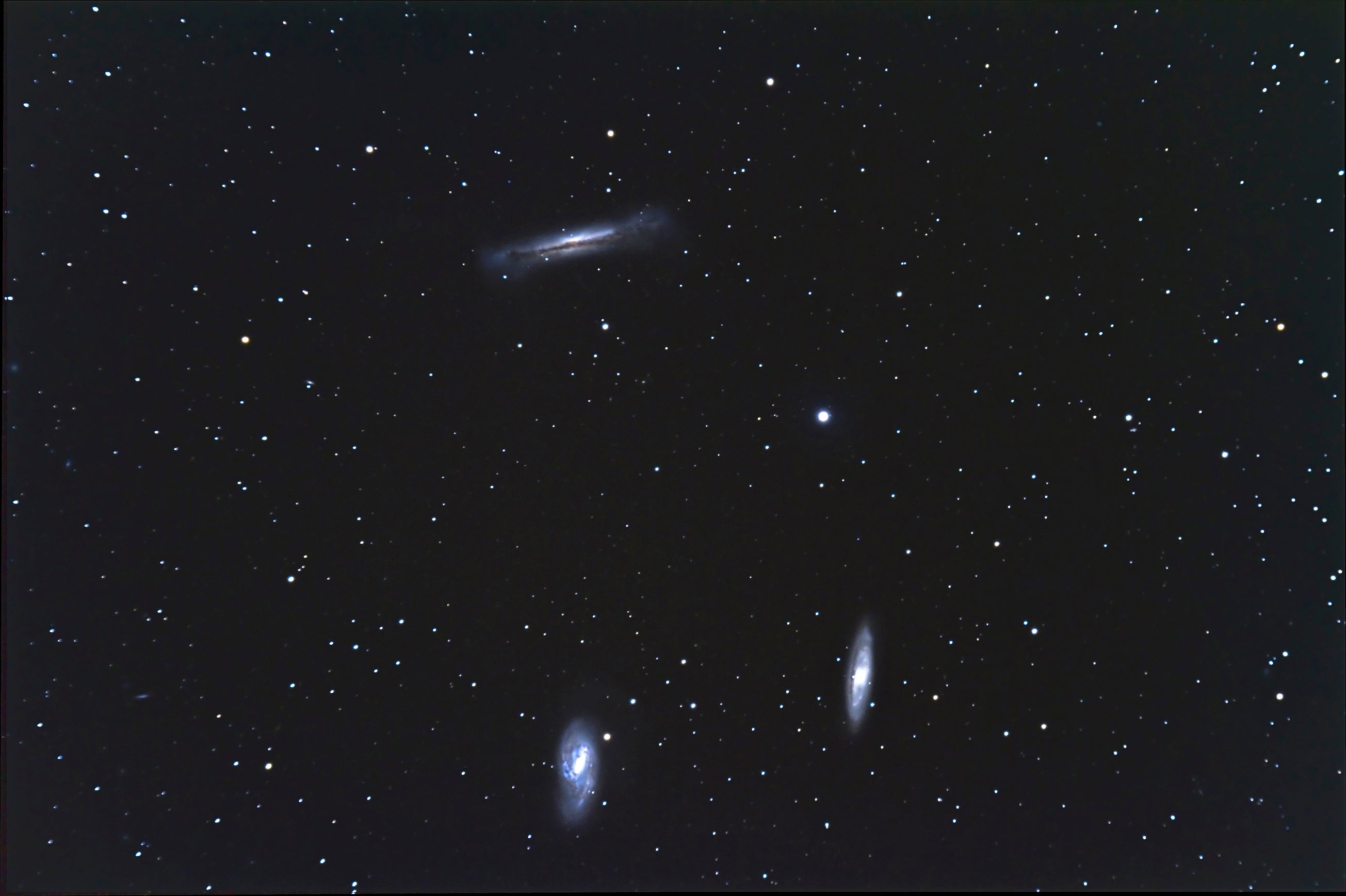
(Credit: Alan Dyer)
1. The Leo Triplet — M65, M66, and NGC 3628 — are all spiral galaxies located about 35 million light-years away. They are close enough to be seen in the same low-power telescopic field, yet far enough from one another that they are minimally interacting. M65 is magnitude 9.6, M66 is 8.9, and NGC 3628 is a deceptive 9.5. At 15′ by 3.6′, NGC 3628 is the largest galaxy of the triplet. Inclined edge-on and dimmed by a thick lane of light-absorbing dust, it’s much harder to spot, despite its brighter magnitude. M65 (8.7′ by 2.2′) and M66 (8.2′ by 3.9′) are classified as SAB galaxies, which are intermediate galaxies that fall between normal and barred spirals.
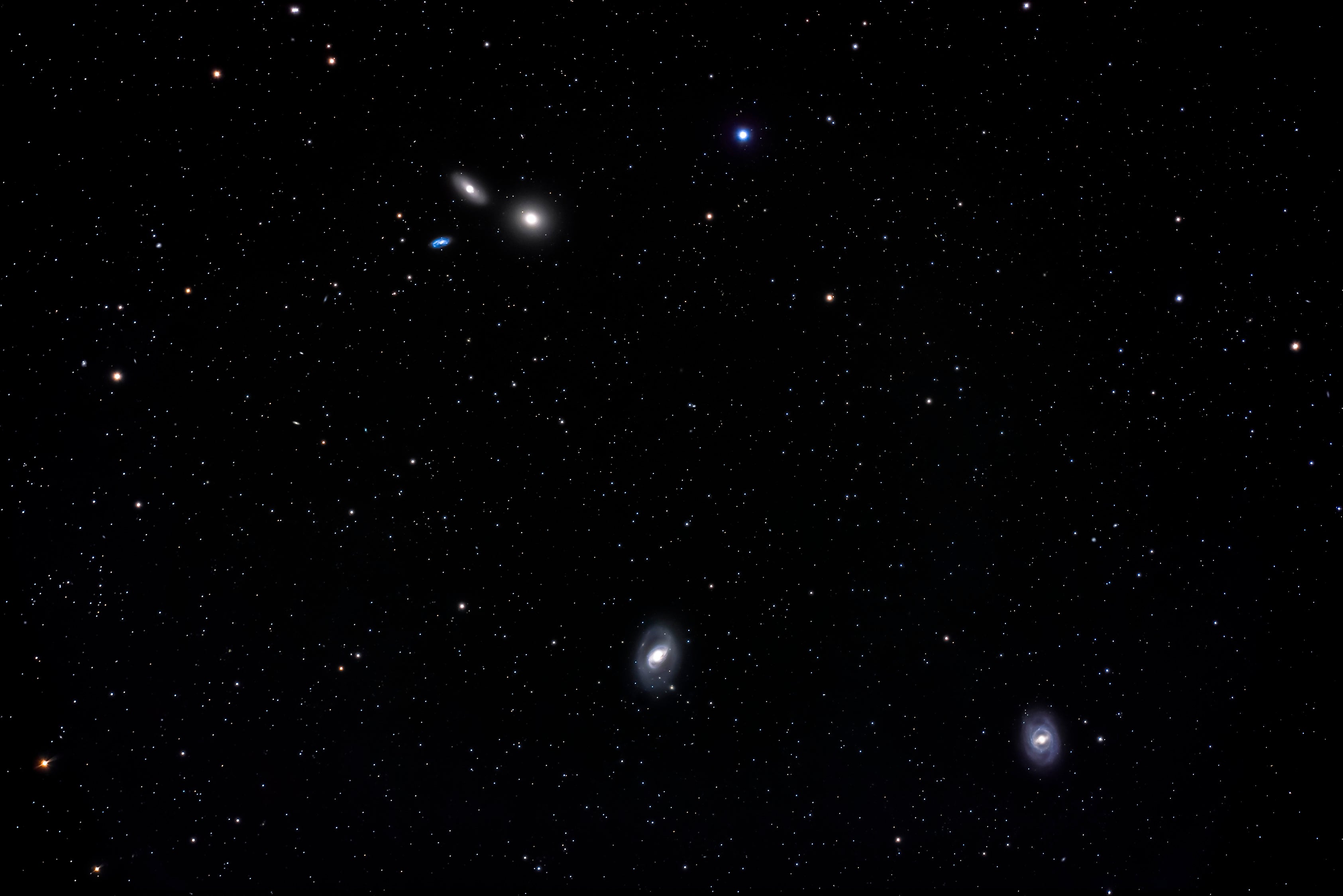
3. Markarian’s Chain forms the core of the Virgo Cluster. Members include M84, M86, NGC 4435, NGC 4438, NGC 4458, NGC 4461, NGC 4473, and NGC 4477. This alignment of galaxies is beyond the usual reach of wide-field telescopes, as its members stretch across about 3°. However, it is possible to see several galaxies with low power. By scanning, you can sweep the entire chain. NGC 4435 and NGC 4438 are an interacting pair known as Arp 120, also called The Eyes. The fainter NGC 4435 is a barred lenticular galaxy while NGC 4438 is a larger spiral, heavily distorted with clumpy dust clouds. The apparent distortion is due to a somewhat edge-on ring of blue stars. Not part of the chain but still worth exploring are the edge-on galaxies NGC 4388, which forms the point of a triangle with M84 and M86, and NGC 4402, located north of M86. NGC 4458 and NGC 4461 form another link in the chain.
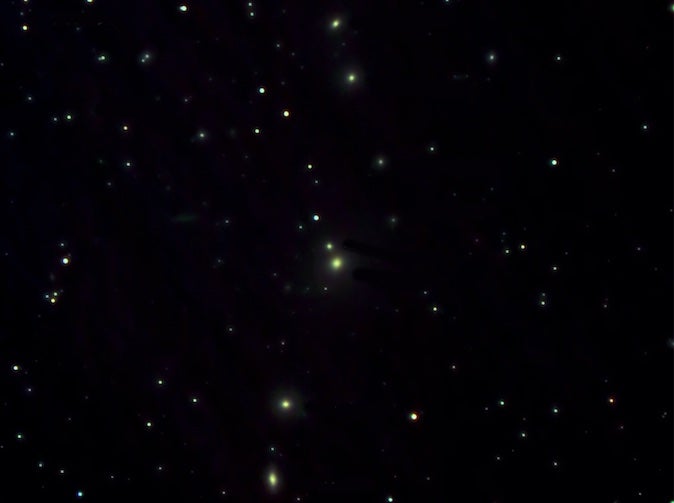
4. The Pisces galaxy cloud (Arp 331) is a great object for telescopes 10 inches and up. It is an apparent north-south alignment of eight galaxies: NGC 379 (magnitude 12.9), NGC 380 (12.5), NGC 382 (13.2), NGC 383 (12.4), NGC 384 (13.1), NGC 385 (13.0), NGC 386 (14.3), and NGC 387 (15). Its faintest member, NGC 387, requires a 16-inch scope. In the same field but not in the chain are NGC 373 (magnitude 13.1), NGC 375 (13.1), and NGC 388 (14.3). With so many galaxies crammed into a relatively small field, this chain is the most dazzling part of the Perseus-Pisces Supercluster.
5. The Eridanus A Group, part of the giant Eridanus Cluster, lies between some 75 million and 180 million light-years distant. Centered around a declination of about –18°30’30”, it’s an easy target for mid-latitude observers. The core consists of seven early-type galaxies. NGC 1407 and NGC 1400 are class E0 ellipticals. NGC 1402, NGC 1391, and IC 343 are class SB0 barred lenticulars. NGC 1393 and NGC 1394 are regular class S0 lenticulars. The galaxies range in magnitude from 9.7 (NGC 1407) to 13.2 (NGC 1391 and IC 343), making this group easy to unlock with an 8-inch telescope under good skies. Four of the galaxies form a diamond, while the three outliers create a chain to the north — an obscure but fascinating winter target.
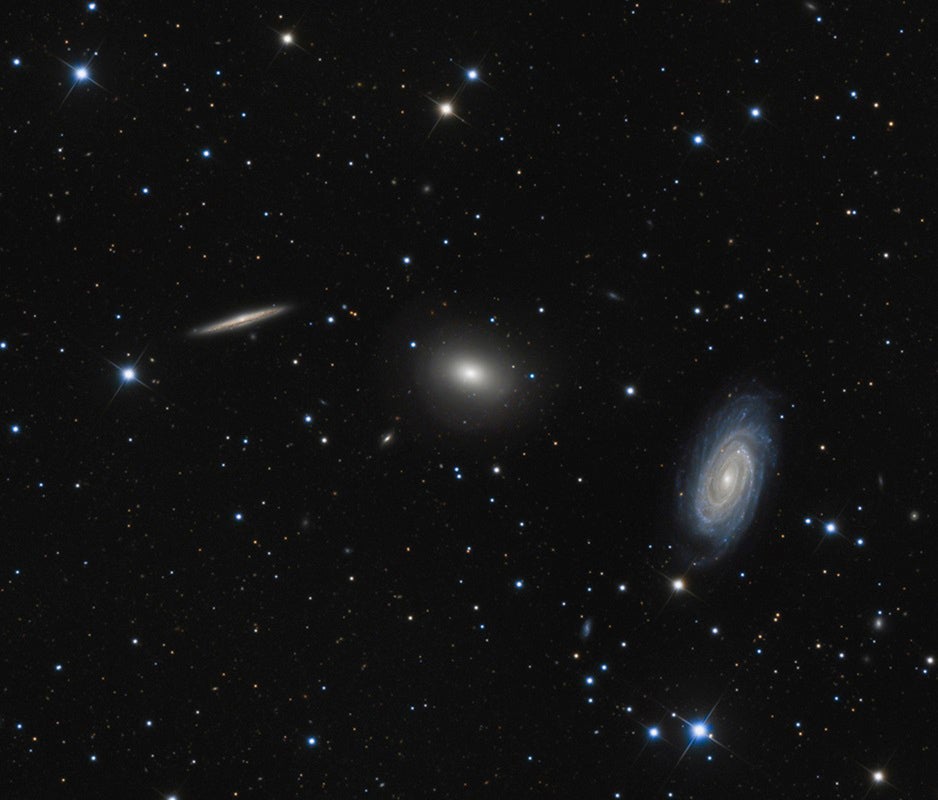
6. The Draco Trio consists of NGC 5981, NGC 5982, and NGC 5985, located some 130 million light-years away. With two spirals and an elliptical galaxy oriented at different angles, this trinity has variety. The group’s brightest two members are magnitude 11.1, making them visible through modest scopes. NGC 5982 is a class E3 elliptical with a slight oval shape and sports a condensed nucleus. NGC 5985, meanwhile, with its compact central bar and ringlike spiral arms, resembles M109 (NGC 3992) in images. On the opposite side of NGC 5982 lies the edge-on spiral NGC 5981. At 13th magnitude, it can be picked up easily in an 8-inch telescope.
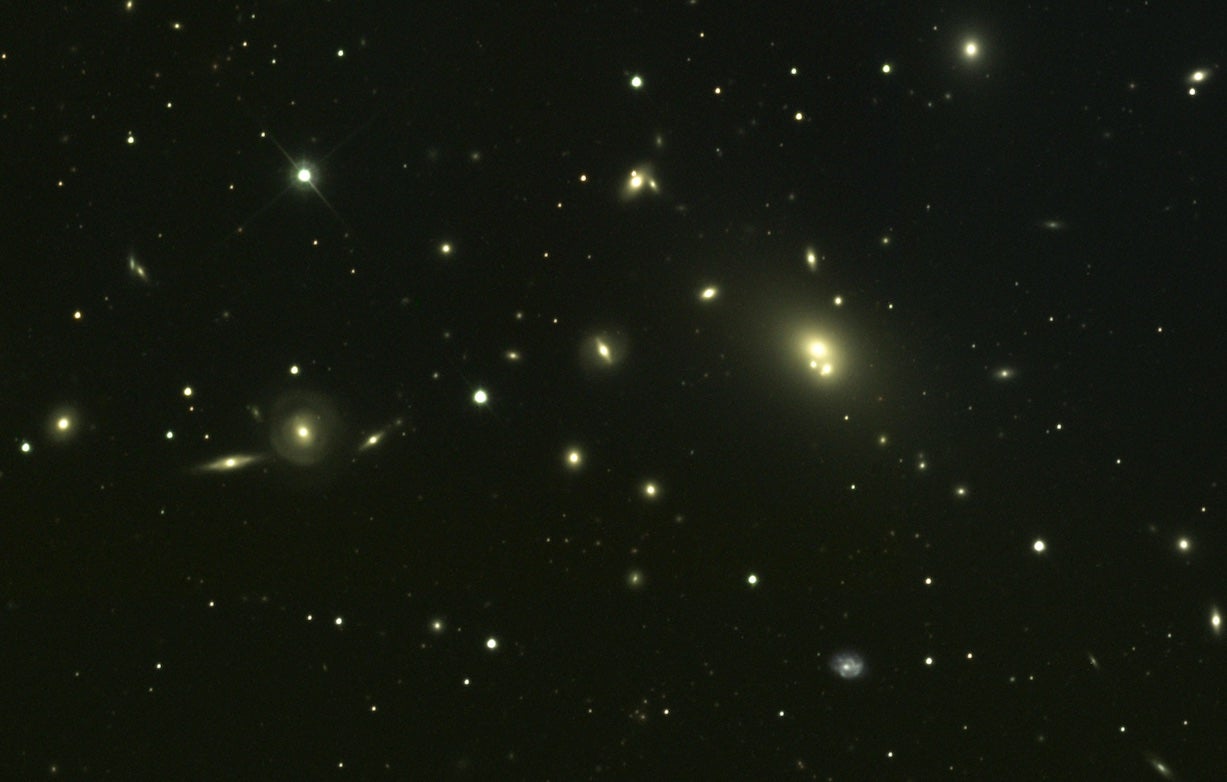
7. Abell 2199 in Hercules is dominated by the cannibalistic galaxy NGC 6166. This galaxy has several nuclei, which are the leftover cores of galaxies that it gobbled up in the past. Classified as a type cD2 peculiar, such mega-galaxies are only found in galaxy clusters and may contain a trillion or more stars. (For comparison, the Milky Way contains roughly 200 billion stars.) NGC 6166 lies some 450 million light-years away, so it appears just 2.1′ by 1.7′ in size. In spite of its vast distance, this magnitude 11.8 target is bright enough see in modest telescopes. With larger apertures, try to find any of the five nuclei within, designated NGC 6166 A through E. With a 12-inch or larger scope, neighboring galaxies may become visible, depending on atmospheric transparency. In 16- to 25-inch scopes, the number of galaxies in the field increases dramatically. If you are seeking a similar galaxy, track down NGC 2832 in Lynx. It forms the core of Abell 779, another major galaxy cluster.
8. NGC 7172, NGC 7173, NGC 7174, and NGC 7176 is a great group for observers with a good southern horizon view of the “tail” of Piscis Austrinus the Southern Fish. Each member is a respectable size, ranging from 2.8′ by 1.4′ to 4.4′ by 2.4′. And with magnitudes around 12, they can all be seen in modest telescopes if atmospheric haze is minimal. For those in the southern U.S., it’s an easy group to find, residing roughly 12° west-southwest of Fomalhaut, the brightest star in that part of the sky. NGC 7173, NGC 7174, and NGC 7176 are an interacting group (Hickson 90) consisting of two ellipticals and a warped spiral galaxy that is nearly lenticular. NGC 7172 is a lenticular, type 2 Seyfert galaxy with an active nucleus surrounded by dust clouds.
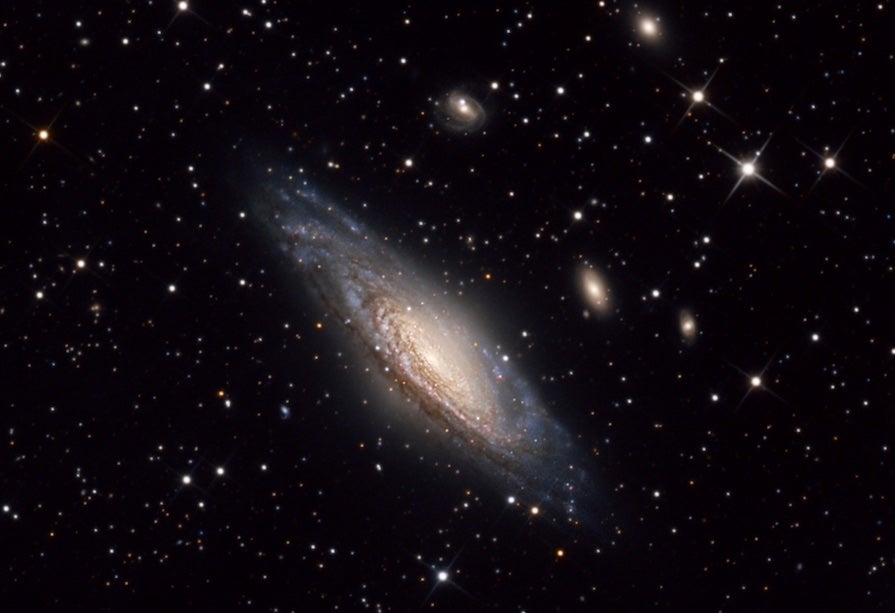
9. NGC 7331, Pegasus’ brightest galaxy, lies in the foreground of a larger gathering of galaxies. Unlike the previous selection, none of these galaxies are close to each other in space. NGC 7331, an Sb spiral galaxy, is magnitude 9.5 — brighter than many Messier objects. At 50 million light-years distant, its dimensions are a generous 10.5′ by 3.5′. The background objects NGC 7335, NGC 7336, NGC 7337, and NGC 7340 are fainter (ranging from magnitude 13 to 15), smaller (1.3′ across or less), and roughly six to eight times farther than NGC 7331. They are strung out from the closest, NGC 7340, an E3 elliptical galaxy about 294 million light-years away, to the farthest, NGC 7336, an Sbc spiral located about 365 million light-years away. In between are NGC 7335, a lenticular galaxy, at 332 million light-years, and NGC 7337, an SBb barred spiral some 348 million light-years distant. About half a degree southwest of NGC 7331 lies the famous Stephan’s Quintet, a favorite galaxy group of many observers. The only reason it’s not on this list is because it’s on so many others!
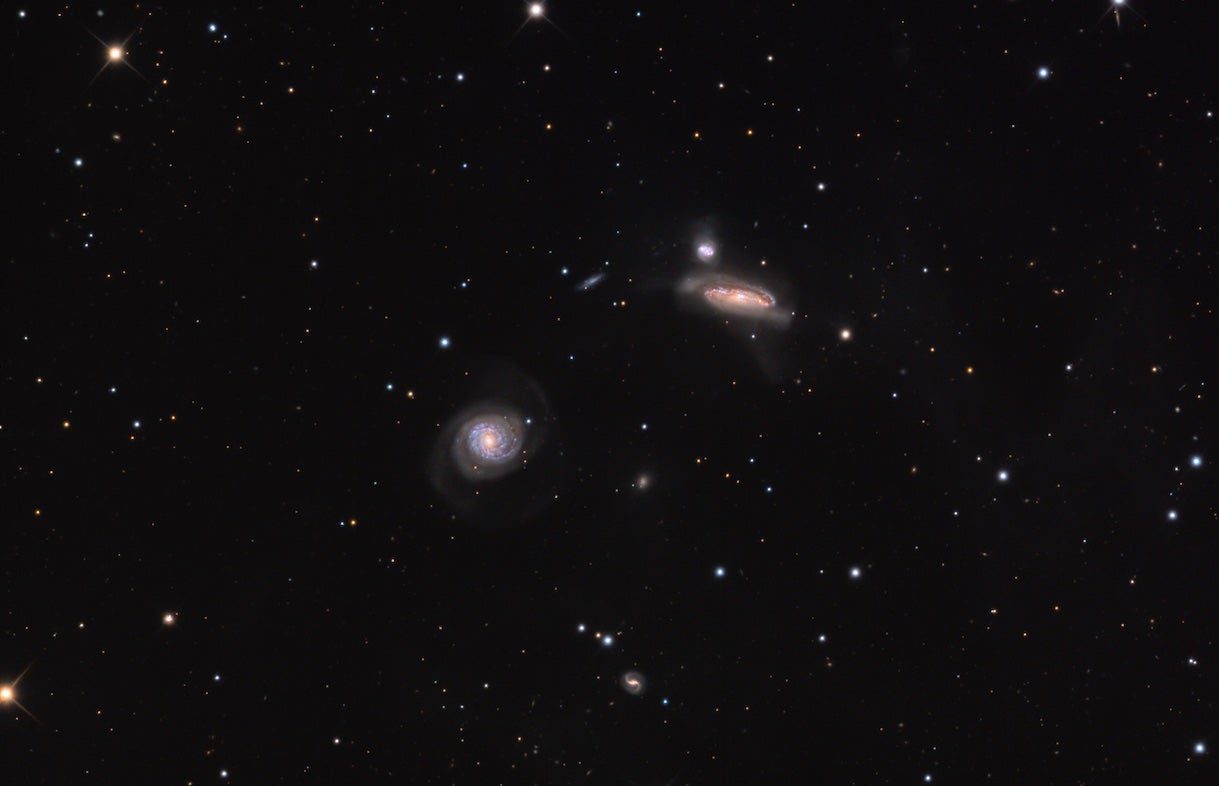
10. NGC 7769, NGC 7770, and NGC 7771 form another interesting group in Pegasus that is located some 200 million light-years away. This target flies under many observers’ radar, often overshadowed by the galaxy groups mentioned in the previous entry. Nonetheless, it’s a cool collection of galaxies to explore. NGC 7769 is a 12th-magnitude Sb face-on spiral (1.6′ across) with a dazzling nucleus. NGC 7771 is a magnitude 12.2 SBb barred spiral that is highly inclined and just 2.3′ by 1.1′ across. It is interacting with NGC 7770, a compact, distorted spiral galaxy that deep photographs reveal is comma-shaped with an offset nucleus. At magnitude 13.8, a 12-inch or larger scope may be required to unlock it. Observing these two is to look upon a freeze-frame of a galactic ballet, with one galaxy in the throes of merging with another. The third member of the trio, NGC 7769, is also an interacting part of this group. Markarian 331, a background magnitude 13.9 SBb galaxy to the north, may be seen with a 12- to 14-inch telescope under good skies. All in all, this is a busy group! Deep astroimages may also reveal a filigree of dust clouds throughout the field above the Milky Way’s galactic plane.
The next clear night, get out there and see how many galaxies you can observe — it doesn’t take a group effort!









